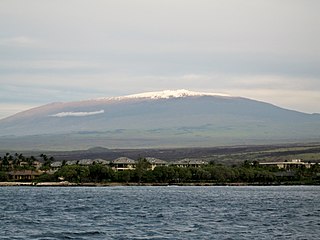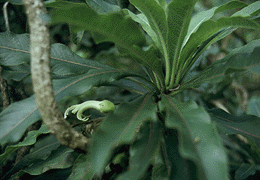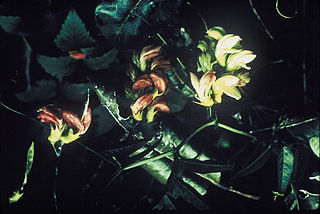
Brisbane Water National Park is a national park on the Central Coast of New South Wales, Australia. The national park is situated 70 kilometres (43 mi) north of Sydney and 12 kilometres (7.5 mi) southwest of Gosford. It consists the Brisbane Water and Mooney Mooney Creek waterways.

Mauna Kea is a dormant shield volcano on the island of Hawaiʻi. Its peak is 4,207.3 m (13,803 ft) above sea level, making it the highest point in Hawaii and the island with the second highest high point, behind New Guinea, the world's largest tropical island with multiple peaks that are higher. The peak is about 38 m (125 ft) higher than Mauna Loa, its more massive neighbor. Mauna Kea is unusually topographically prominent for its height: its prominence from sea level is fifteenth in the world among mountains, at 4,207.3 m (13,803 ft); its prominence from under the ocean is 9,330 m (30,610 ft), rivaled only by Mount Everest. This dry prominence is greater than Everest's height above sea level of 8,848.86 m (29,032 ft), and some authorities have labeled Mauna Kea the tallest mountain in the world, from its underwater base. Mauna Kea is ranked 8th by topographic isolation.

The mountain tapir, also known as the Andean tapir or woolly tapir, is the smallest of the four widely recognized species of tapir. It is found only in certain portions of the Andean Mountain Range in northwestern South America. As such, it is the only tapir species to live outside of tropical rainforests in the wild. It is most easily distinguished from other tapirs by its thick woolly coat and white lips.

Habitat fragmentation describes the emergence of discontinuities (fragmentation) in an organism's preferred environment (habitat), causing population fragmentation and ecosystem decay. Causes of habitat fragmentation include geological processes that slowly alter the layout of the physical environment, and human activity such as land conversion, which can alter the environment much faster and causes the extinction of many species. More specifically, habitat fragmentation is a process by which large and contiguous habitats get divided into smaller, isolated patches of habitats.

Argyroxiphium sandwicense, the Hawaiʻi silversword, or hinahina is a species of silversword. It is endemic to Hawaii. The two subspecies are separated by geography. Both subspecies are rare, threatened and federally protected.

The Mauna Loa silversword, Argyroxiphium kauense, or Kaʻū silversword, is a rare species of flowering plant in the aster family. It is endemic to the eastern and southern slopes of Mauna Loa on the island of Hawaiʻi. A. kauense occurs in mountainous shrublands, bogs, and open mesic forest. The species is managed by the National Park Service and Hawaiʻi State Department of Forestry and Wildlife. It is a federally listed endangered species of the United States. There are three known populations remaining, for a total of fewer than 1000 individuals.
Genetic erosion is a process where the limited gene pool of an endangered species diminishes even more when reproductive individuals die off before reproducing with others in their endangered low population. The term is sometimes used in a narrow sense, such as when describing the loss of particular alleles or genes, as well as being used more broadly, as when referring to the loss of a phenotype or whole species.

Pōhakuloa Training Area (PTA) is a US military training base located on the high plateau between Mauna Loa, Mauna Kea and the Hualālai volcanic mountains of the island of Hawaiʻi. It includes a small military airstrip known as Bradshaw Army Airfield.

Defaunation is the global, local, or functional extinction of animal populations or species from ecological communities. The growth of the human population, combined with advances in harvesting technologies, has led to more intense and efficient exploitation of the environment. This has resulted in the depletion of large vertebrates from ecological communities, creating what has been termed "empty forest". Defaunation differs from extinction; it includes both the disappearance of species and declines in abundance. Defaunation effects were first implied at the Symposium of Plant-Animal Interactions at the University of Campinas, Brazil in 1988 in the context of Neotropical forests. Since then, the term has gained broader usage in conservation biology as a global phenomenon.
Bobcat Trail Habitation Cave is a historic site of Ancient Hawaiian living quarters in a remote interior area of the island of Hawaiʻi.

Argyroxiphium sandwicense subsp. sandwicense, the Mauna Kea silversword, is a highly endangered flowering plant endemic to the island of Hawaiʻi of Hawaii. It is the "crown jewel" of the volcanic mountain Mauna Kea, from which it derives its English name. The Hawaiian name is ʻahinahina; it applies to silverswords more broadly. The Mauna Kea silversword was once common on the volcano, and extraordinary conservation efforts are being made to preserve the species.

The Cantabrian capercaillie is a subspecies of the western capercaillie in the grouse family Tetraonidae. It is one of two subspecies found in Spain.

Clermontia pyrularia is a rare species of flowering plant in the bellflower family known by the common names Hamakua clermontia and pear clermontia. It is one of several Hawaiian lobelioids in genus Clermontia that are known as ʻoha wai and haha. It is endemic to the island of Hawaiʻi, where there is one remaining wild population containing 15 individuals and several propagated individuals that have been planted in protected habitat. This is a federally listed endangered species of the United States.

Conradina brevifolia is a rare species of shrub in the mint family known by the common name short-leaved false rosemary. It is endemic to Central Florida, where it is known only from the Lake Wales Ridge. There are perhaps 36 occurrences of the plant remaining, and 10 of these are likely to be destroyed as their habitat is fragmented in the coming years. About 15% of the Lake Wales Ridge, the only home territory of the plant, remains today, the rest having been cleared for development and citrus groves. Few of the extant populations have more than 25 plants. This is a federally listed endangered species of the United States.
Silene hawaiiensis is a rare species of flowering plant in the family Caryophyllaceae known by the common names Hawai'i catchfly, Hawaiian catchfly and Sherff's catchfly. It is endemic to Hawaii, where it is known only from the island of Hawaii. It is threatened by the degradation of its habitat and it is a federally listed threatened species of the United States.
Stenogyne angustifolia is a rare species of flowering plant in the mint family known by the common name narrowleaf stenogyne. It is endemic to Hawaii, where it is known from the island of Hawaii; it has been extirpated from the islands of Molokai and Maui.
Tetramolopium arenarium is a rare species of flowering plant in the family Asteraceae known by the common name Maui tetramolopium. It is endemic to Hawaii, where it is known only from the island of Hawaii. It is extirpated from Maui. It is threatened by the degradation of its habitat. It is a federally listed endangered species of the United States.

Vicia menziesii is a rare species of flowering plant in the legume family known by the common name Hawaiian vetch. It is endemic to Hawaii, where it is known only from the island of Hawaii. It is threatened by habitat loss and exotic plants. It has been federally listed as an endangered species of the United States since 1978. It was the first Hawaiian plant to be placed on the Endangered Species List.

The lowland anoa(Bubalus depressicornis) is a species of buffalo endemic to Sulawesi. Its closest relative is the mountain anoa, and it is still a debate as to whether the two are the same species or not. It is also related to the water buffalo, and both are classified in the genus Bubalus.
Haplostachys (honohono) is a genus of flowering plants in the mint family, Lamiaceae, first described as a genus in 1888. The entire genus is endemic to the Hawaiian Islands, although 4 of the 5 known species that have been placed in the genus are now believed to be extinct, the fifth listed as "Critically Imperiled."














